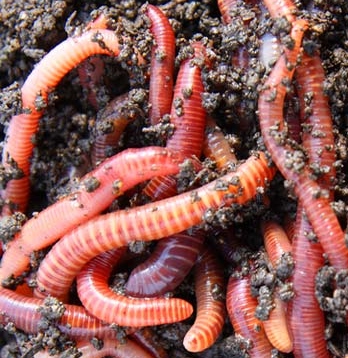Organic red worms: Perfect for sustainable gardening
Wiki Article
Utilizing Red Wigglers for Reliable Organic Garbage Disposal
These worms not just enhance waste decay yet additionally generate beneficial worm castings, which can significantly improve dirt wellness. Recognizing the nuances of setting up a successful worm container and keeping an ideal habitat is vital for optimizing their advantages.Advantages of Making Use Of Red Wigglers
One of one of the most compelling advantages of utilizing red wigglers for organic waste disposal is their remarkable efficiency in composting. These worms, medically referred to as Eisenia fetida, are specifically adjusted for damaging down natural materials, allowing them to process waste approximately twice their body weight every day. This fast disintegration not just accelerates the composting process yet additionally creates nutrient-rich worm castings that substantially boost soil high quality.In addition, red wigglers add to a decrease in land fill waste. By drawing away organic materials from landfills, they help lessen methane discharges-- a powerful greenhouse gas. This ecological benefit is essential in the fight versus climate modification.
In addition, red wigglers are low-maintenance and can thrive in various atmospheres, making them obtainable for both novice and skilled composters. Their ability to recreate promptly makes sure a steady population, promoting continuous waste handling.
Establishing Your Worm Bin
Developing an effective worm container is necessary for optimizing the advantages of composting with red wigglers. The primary step is selecting an appropriate container. A container made of plastic or wood, with a capacity of 10 to 20 gallons, is suitable. Guarantee the container has ample drainage openings to avoid excess moisture, as red wigglers grow in a moist yet not soggy setting.(red wiggler fishing worms)Next, prepare the bed linen material, which serves as the worms' habitat and food resource. The container must be placed in a dark, temperature-controlled area, preferably in between 55 ° F and 77 ° F, to keep worm task.
As soon as the bin is set up, present the red wigglers, enabling them to acclimate to their new environment. A properly maintained bin will certainly not only support the wellness of the worms yet additionally facilitate effective decomposition of natural waste.
(Lake Rhodhiss Bait)
What to Feed Red Wigglers
An understanding of the ideal diet regimen for red wigglers is important for keeping a healthy worm populace and optimizing composting effectiveness. These items not just provide essential nutrients however additionally contribute to the moisture balance within the worm container.It is essential to stay clear of specific foods that can damage the worm populace. Red wigglers need to not be fed meat, milk items, oily foods, or processed items, as these can bring in insects and produce undesirable smells. red wigglers. In addition, citrus fruits and hot foods must be lessened, as their level of acidity can be detrimental to worms
Keeping an eye on the worm container for food intake prices will certainly help make certain that red wigglers are getting a sufficient diet plan while keeping a reliable composting environment. Proper feeding practices are essential for promoting a growing ecological community within the worm container.
Maintaining Your Worm Habitat
A properly maintained worm habitat is necessary for the wellness and efficiency of red wigglers. To make sure optimal problems, it is critical to monitor temperature, wetness, and oygenation within the worm container. Red wigglers prosper in a temperature level array of 55 to 77 degrees Fahrenheit. Exceeding this variety can stress the worms, so it's important to put the container in a suitable place away from straight sunlight and extreme temperature levels.Dampness levels should be kept constant; the bedding ought to be moist but not soaked. A good guideline is to preserve wetness at about 70% to 80%. If the bed linen becomes too wet, it can lead to anaerobic conditions that are hazardous to the worms. Including dry carbon-rich materials, such as shredded paper or cardboard, can aid soak up excess dampness.

Making Use Of Worm Spreadings in Gardening
Rich in nutrients and helpful bacteria, worm spreadings work as an outstanding natural plant food for gardening. Produced through the my latest blog post digestive system procedures of red wigglers, these spreadings include an array of important nutrients, including nitrogen, phosphorus, and potassium, which advertise durable plant development. Unlike synthetic plant foods, worm spreadings provide a slow-release system, making sure that nutrients are readily available to plants over an extended duration, thus minimizing the threat of nutrient leaching and soil exhaustion.In addition to vitamins and mineral material, worm castings improve dirt structure and oygenation, enhancing dampness retention and drainage. The microbial life existing in worm castings aids to suppress microorganisms and promotes a healthy and balanced soil environment, further benefiting plant health. When incorporated right into the dirt or used as a top dressing, worm castings can considerably enhance seed germination rates, origin development, and total plant vigor.
For optimum outcomes, gardeners must apply worm castings at a rate of 1-2 inches per square foot, mixing them right into the dirt or integrating them into potting blends. Generally, utilizing worm castings is an eco-friendly strategy to enriching dirt fertility and guaranteeing prospering garden environments.
Conclusion

Report this wiki page